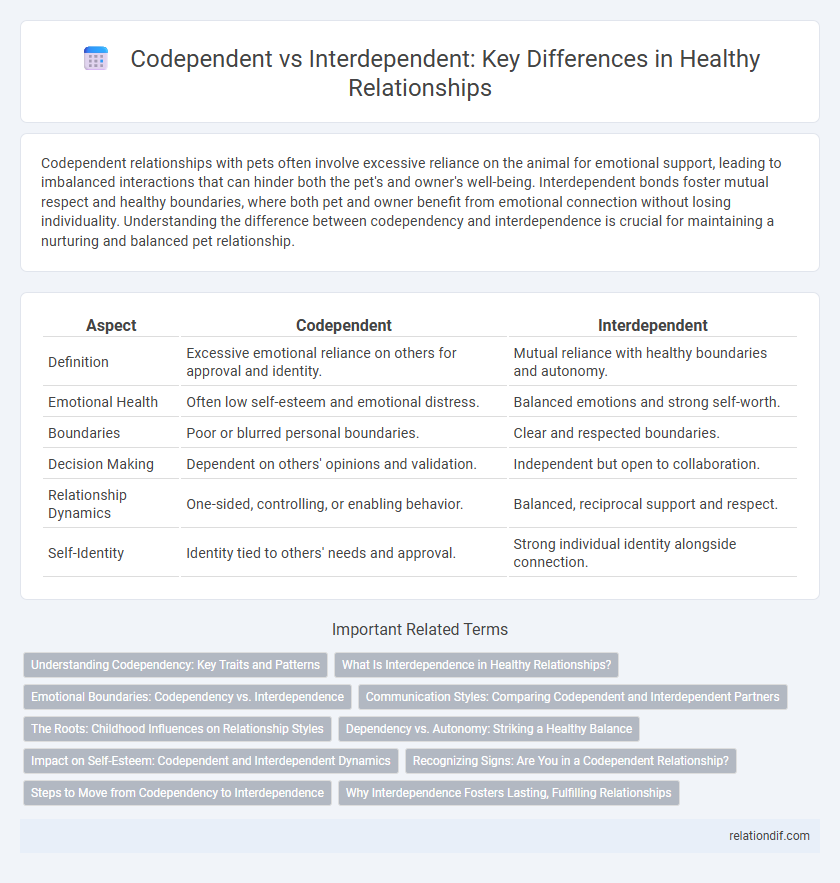Codependent relationships with pets often involve excessive reliance on the animal for emotional support, leading to imbalanced interactions that can hinder both the pet's and owner's well-being. Interdependent bonds foster mutual respect and healthy boundaries, where both pet and owner benefit from emotional connection without losing individuality. Understanding the difference between codependency and interdependence is crucial for maintaining a nurturing and balanced pet relationship.
Table of Comparison
| Aspect | Codependent | Interdependent |
|---|---|---|
| Definition | Excessive emotional reliance on others for approval and identity. | Mutual reliance with healthy boundaries and autonomy. |
| Emotional Health | Often low self-esteem and emotional distress. | Balanced emotions and strong self-worth. |
| Boundaries | Poor or blurred personal boundaries. | Clear and respected boundaries. |
| Decision Making | Dependent on others' opinions and validation. | Independent but open to collaboration. |
| Relationship Dynamics | One-sided, controlling, or enabling behavior. | Balanced, reciprocal support and respect. |
| Self-Identity | Identity tied to others' needs and approval. | Strong individual identity alongside connection. |
Understanding Codependency: Key Traits and Patterns
Codependency is characterized by excessive emotional reliance on others, often leading to a loss of personal identity and difficulty setting boundaries. Common traits include people-pleasing behavior, low self-esteem, and a compulsive need to control or fix others' problems. Unlike interdependence, which fosters mutual respect and healthy boundaries, codependency creates imbalanced relationships driven by insecurity and fear of abandonment.
What Is Interdependence in Healthy Relationships?
Interdependence in healthy relationships means both partners maintain their individuality while supporting each other's growth and emotional needs, creating a balanced dynamic. Unlike codependency, interdependence fosters mutual respect, effective communication, and shared responsibility without losing personal boundaries. This approach promotes resilience and emotional well-being, enabling partners to thrive independently and together.
Emotional Boundaries: Codependency vs. Interdependence
Emotional boundaries in codependency are often blurred, with individuals sacrificing their needs and emotions to please others, leading to unhealthy dependence. In contrast, interdependence maintains clear emotional boundaries where both parties support each other's well-being while preserving their own autonomy. Healthy interdependence promotes mutual respect, emotional self-regulation, and balanced give-and-take in relationships.
Communication Styles: Comparing Codependent and Interdependent Partners
Codependent partners often exhibit communication styles marked by passive-aggressiveness, excessive caretaking, and difficulty expressing personal needs, leading to imbalance and resentment. Interdependent partners engage in open, honest dialogue that honors both individuals' feelings and boundaries, fostering mutual respect and problem-solving. Effective interdependent communication promotes emotional autonomy while maintaining connection, contrasting with codependent patterns rooted in anxiety and control.
The Roots: Childhood Influences on Relationship Styles
Codependent relationship patterns often stem from childhood environments where emotional needs were unmet, leading to excessive reliance on others for validation and self-worth. Interdependent relationships, by contrast, develop from secure attachments and healthy boundaries formed during childhood, fostering mutual support without losing individuality. Understanding these foundational experiences is crucial for recognizing how childhood influences shape adult relational dynamics and emotional health.
Dependency vs. Autonomy: Striking a Healthy Balance
Codependency often involves excessive emotional reliance on others, leading to a loss of personal autonomy and unhealthy dependency patterns. Interdependence fosters a balanced relationship where both individuals maintain autonomy while supporting each other's growth and well-being. Striking a healthy balance between dependency and autonomy enhances mutual respect and promotes emotional resilience.
Impact on Self-Esteem: Codependent and Interdependent Dynamics
Codependent dynamics often lead to diminished self-esteem as individuals rely heavily on others for validation and approval, creating a cycle of dependency and self-doubt. In contrast, interdependent relationships foster healthy self-esteem by promoting mutual support while maintaining personal autonomy and self-respect. Understanding these dynamics helps recognize that interdependence enhances emotional resilience, whereas codependency undermines individual confidence and self-worth.
Recognizing Signs: Are You in a Codependent Relationship?
Recognizing signs of codependency involves identifying patterns of excessive caretaking, difficulty setting boundaries, and prioritizing others' needs over your own emotional well-being. Interdependent relationships, in contrast, feature mutual support where both individuals maintain autonomy while relying on one another in a healthy balance. Key indicators of codependency include chronic people-pleasing, fear of abandonment, and a sense of identity tied to the partner's approval or happiness.
Steps to Move from Codependency to Interdependence
Recognizing unhealthy reliance on others is the first step in shifting from codependency to interdependence. Establishing clear personal boundaries and developing self-awareness fosters emotional autonomy and balanced relationships. Practicing effective communication and embracing mutual support helps build equitable connections that promote growth for both individuals.
Why Interdependence Fosters Lasting, Fulfilling Relationships
Interdependence fosters lasting, fulfilling relationships by promoting mutual respect, balanced support, and healthy boundaries, unlike codependency which often involves excessive reliance and loss of individuality. This dynamic encourages both partners to maintain their autonomy while collaborating, enhancing emotional growth and resilience. Research shows that interdependent relationships exhibit higher levels of trust and satisfaction, key factors in long-term relationship success.
Codependent vs Interdependent Infographic

 relationdif.com
relationdif.com